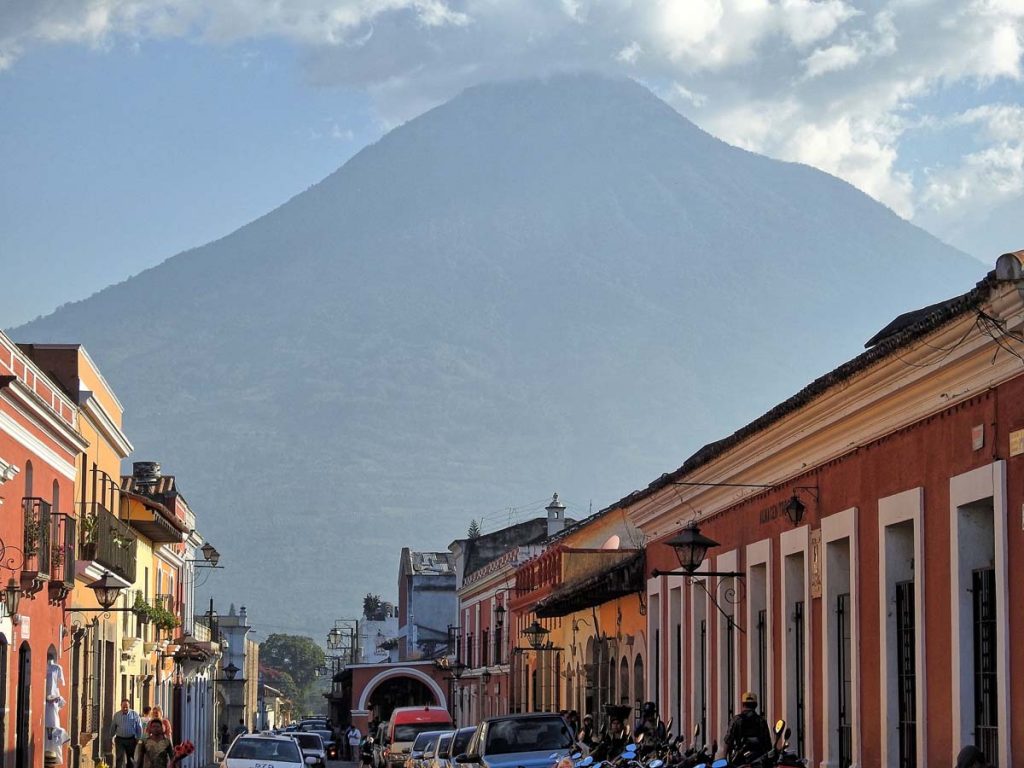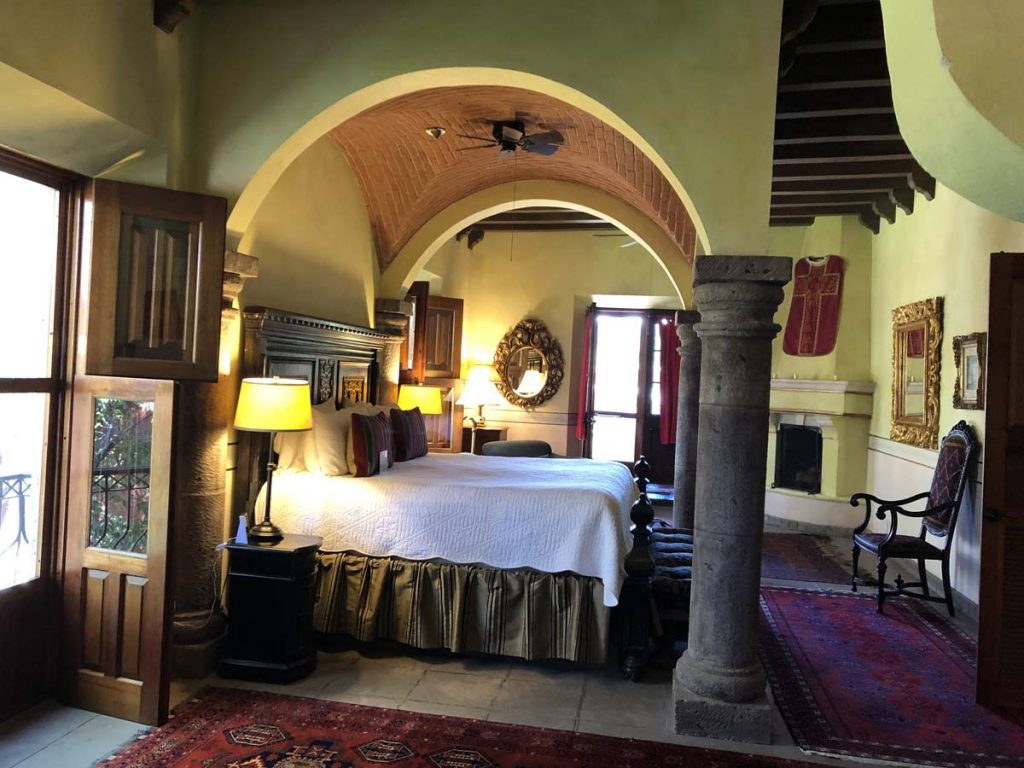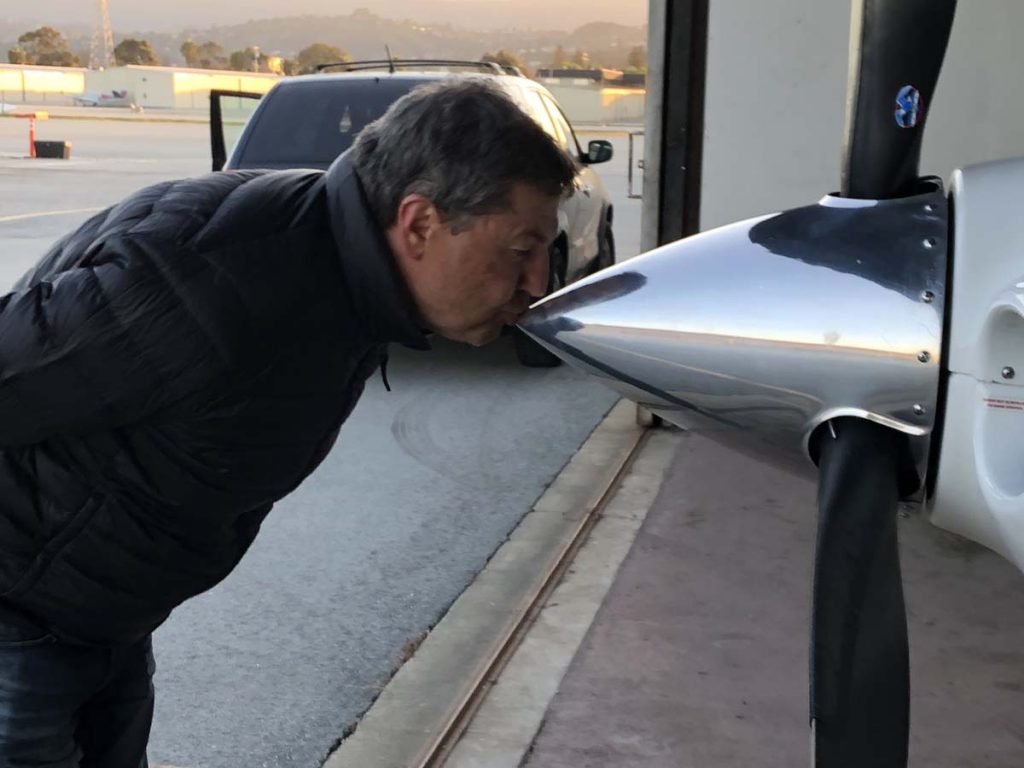Here we are on Wednesday morning in Guayaquil, Ecuador, about 120 miles South of equator, a mere 3,400 nautical miles straight line distance from home. Staying over land adds another 900 nm and we want to be home on Sunday. The airplane doesn’t fly as well as usual, but we are determined to get back.
Wednesday
We arrived to the airport in Guayaquil around 8 am. I talked to a mechanic in Xavier’s shop about timing the magneto, but decided it would take too much time. I knew the airplane flied, it just didn’t fly well. Following the principle of great being enemy of good and a risk of further delays if something went bad, we decided to launch and we were airborne about 9 am. Flavio at Airmaster FBO handled efficiently all our paperwork.
I filed for 10,000, because I wanted to stay low suspecting there was something wrong with mag pressurization. During the climb I watched nervously manifold pressure as it kept dwindling down to 27, 26, 25 inches. The engine run fine, fuel flow was good and the airplane climbed normally, so this was clearly an indication problem. That’s what your conscious brain tells you, but after all the troubles with the mags and the associated maintenance and the fact that you are far from home and literally in the other hemisphere, your unconscious brain starts screaming. Score one for the conscious brain.
The flight to Cali took about 2:45 and we were all the time comfortable above a broken layer. We had to climb to 16,000 for the last 60 miles due to MEAs, so I just went full rich. The ILS to Cali was out of service, I requested and got cleared for RNAV Z, but they vectored me for a VOR approach. This was a formality though, because I broke into clear at 12,000 and continued visual. We landed somewhat anxious about what the delay will be, mindful of our previous exit experience. This time though we hired a handler and we are out in 30 minutes, including bathroom, refuel and flight plans.
When on the ground, I checked my messages and found that John, who was flying from Pereira to Costa Rica had a rough engine with a partial power loss, declared emergency and landed in Rionegro (SKRG) close to Medellin. Everybody was OK, airplane was fine on the ground, but the nightmare of paperwork started. Declaring an emergency in US is a non-event and most of the time, there is not even a report to file, but here we were dealing with an international incident He didn’t know how long he might have to stay in Medellin and thought he might need to fly commercial back home and return later to recover the airplane.
We launched for our second leg to Panama City, which was about the same flight time, we flew at 12,000 and the engine was having harder time keeping smooth when LOP, so I simply pull the power back and flew ROP. We had enough fuel reserves and Panama weather was fine. This time, when the Panama Approach controller asked if I was familiar with Gelabert airport, I could reply in my best pilot baritone “affirmative”. I suppose the reason they ask is that there is a hill close to approach end (see this video) and if you are unfamiliar, it may be startling.
Since leaving Guayaquil in the morning I didn’t really know where we were going to end up, I didn’t reserve any hotels in Panama City. After landing, I went on Hotels.com, found Las Clemantinas in Casco Viejo and booked it. The Mapiex FBO was as efficient as the first time and they drove us to the hotel. A surprised clerk checked our reservation and said they didn’t have rooms, something about a cleaning lady having an emergency and unable to prepare it. Another visit to Hotels.com and I found La Concorida in walking distance, we checked in and found a very nice room, huge bathroom, very helpful staff and, most importantly, nice rooftop bar. Since La Concordia is $110 more expensive than Las Clemantinas, I called Hotels.com back and they agreed to refund the difference. All things considered, that was a great day, 5:30 of flight time and we are 800 miles closer home.
There is a Cirrus Service Center in Medellin and the local mechanic came over to check John’s plane. He couldn’t find anything wrong, they went for a short test flight, where everything was OK and John wanted to leave. Well, not so fast, gringo, we have our procedures here, a test pilot must come from Bogota to certify that the plane is fine in spite of the fact that a Cirrus Certified Instructor (John) and a mechanic from Cirrus Service Center say all is good. John stayed in Medellin, but he thought he might leave the next day.
Thursday
We woke up early and were at the airport before 8 am. After departing Gelabert VFR, we had to climb to 16,000 before Costa Rica border – ROP again. We were handed over to Coco control and fifty miles before our first destination, I got vectored for the ILS Z 07 to Juan Santamaria International (MROC), expecting a sidestep to the VFR-only Pavas airport (MRPV). Then, I got vectors for the traffic and that wore my patience thin, I canceled IFR and started dropping like a rock to get down to the airport. After landing we went through the usual luggage X-ray (that’s get old after a while), got gas, paid the handler and we were on our way. Our flight plan was initially for G346 from Liberia to San Salvador VOR, but that would put us quite far offshore. I sent an email in the morning to Melani asking for a different route: A502 to Managua and A317 to CAT. It turns out that the first route is outside of Nicaragua airspace, but the second one is obviously inside and we needed Nicaragua overflight permit. Melani came through and obtained the permit in record time.
We continued through Nicaragua talking to Sandino Control and landed at Guatemala City Aurora airport. As usual, I canceled IFR during the approach and than I heard a familiar voice on the radio. It was our friend Hubert from Arizona who flew with us many times to Mexico. He was part of a COPA-organized trip to Panama City and suddenly there were 12 Cirrus aircrafts at the airport plus Michael’s and mine. We first taxied to the international ramp, went through all inbound processing and than had to cross the runway to park the airplane. Ground control was very much overwhelmed by that sudden onslaught of Cirrus.
Antigua used to be the capital of the Spanish Colony of Guatemala until XVIII century, when Santa Marta earthquakes caused the capital to be moved the current location. We stayed in House Hotel Pensativo, an unexpected surprise of calm and charm, with unrivaled views of the Volcan de Agua. It is an old private house, which was enlarged and turned into a hotel. A gourmet dinner in Casa Santo Domingo made us regret that we had to leave the following day.

In the meantime, John was still stuck in Medellin. While the authorities released his airplane as airworthy, his original import permit established when he entered Colombia in Cartagena has expired. He now needed a new permit and sure enough, that couldn’t be done on the spot. Maybe tomorrow.
Friday
We learned that John got his permit and was leaving Medellin for Pavos (MRPV) in Costa Rica, planning to arrive to Antigua in the evening.
It is about 1.5 hours to drive back to the airport, we took fuel and taxied back on the other side of the runway to the international ramp. The whole processing took less than 30 minutes and we were on our way. A less than an hour flight brought us to Tapachula, Mexico, which is a mandatory Airport of Entry. As much as you can overfly any airport in Mexico coming in from the North as long as you land at an AOE, when you are coming from the South, you must use one of the two AOEs: either Tapachula or Cozumel. I know of people who paid stiff fines for going somewhere else, according to the rule that in Mexico rules are flexible. They are, but not all and you better know which ones are OK to violate. For example, it is not a big deal to fly through restricted areas or enter a TMA without talking to approach control. You theoretically need to file a Mexican version of APIS, but nothing happens if you don’t. Not landing in Tapachula is not one of those.
It was hot, really hot on the ground, we had to take out all the luggage, there was a dog who was sniffing our staff, but unlike in Cali he had boots, so as to not burn his paws. The usual flight plan, customs, immigration took over an hour, but it was a relief to pay only 120 pesos ($6.50) for using the airport. A pilot doesn’t pay anything for immigration if the stay is less than 7 days, a passenger pays 500 pesos for the visa. A helpful commandante gave us a tip to declare the passenger as co-pilot to avoid that fee. I knew about it, but thought that $26 is too low amount to use the trick.
We flew VFR from Tapachula to Zihuatanejo along the coast and it was a pleasure to not have to abide by MEAs enroute. Our original planned stop was Uruapan in the center of the country, but that would have takes us over mountains and with the bad mag timing and a suspicion of incorrect pressurization hookup, I wanted to stay low. The three hour flight was too long to stay ROP, so I pulled the power back to about 25 inches (66%) and managed to lean the mixture with only minimum roughness.
We landed at the Zihuatanejo airport in the early afternoon, took our luggage and after paying 40 pesos landing fee, we walked out of the airport, grabbed a cab and drove to town. Gringos often complain how long the processing is in Mexico, about the fees and having to file flight plans. It is true that compared to US, it is a hassle, but it is getting better each year. More importantly, this is a bad comparison. Just fly further south and you will be so happy to return back to Mexico.
While the hotel was somewhat substandard (that’s what you get without prior reservations and when unwilling to spend $500/night), it was walking distance from the beach, which had few restaurants with tables on the sand. We had two margaritas each and got positively drunk. Unlike in US, they actually pour real tequila and in non-negligible amounts into their margaritas south of the border and we haven’t eaten much during the day. The fish was delicious, the sea breeze and warm night added to the magic of the moment.
Saturday
After paying 80 pesos, filing flight plan, getting usual stamps and refueling, we took off for a 3 hours flight to Mazatlan. Same super-fast and friendly processing and refueling as during our outbound stop makes Mazatlan one of my preferred AOEs. Another 1.5 hours and we landed in Alamos for our overnight stop in Hacienda de Los Santos. It has been 10 years we are coming to the Hacienda and it is our favorite place in the whole country. We run into the owner, Jim Swickard and we told him about our adventures in Colombia and Ecuador. Jim and Nancy have built the Hacienda over thirty years into an amazing thing of beauty. It is located inland, two hours drive from Ciudad Obregon (which has commercial service to Mexico City) therefore it doesn’t attract usual cruise ship crowds. For a pilot with his own airplane, a 5,000 paved runway in Alamos is only 1.5 hour flight from US border. Throughout the years, I brought few COPA Mexico trips to Alamos and the participants became frequent Hacienda’s guests. Jim graciously offered us an upgrade to Governor suite and we were really tempted to stay one more night.

Sunday
It is always both sad and happy to return home. Our great adventure was nearing the end and the familiar trip from Alamos was, as every flight should be, boring. We stopped in Ciudad Obregon for fuel, passed immigration and customs and flew to Calexico. At 66% power and 8,500 our airplane is flying at only 160 knots. This is remainder how easy it is to get used to good things, only three years ago 160 knots was what we were always flying. The stop in Calexico beat all the speed records – probably about 10 minutes to pass inspection and take fuel.
It took us 5 days of flying to get from equator home. We were flying at most 6 hours a day and our bird was not in top shape. If time was of essence, I believe it would be pretty easy to do that trip in 3 days – three days to cross almost a third of the globe. Aren’t airplanes amazing machines? We were very grateful for how our airplane took care of us and after a tender kiss, I closed the hangar doors.

We are back home, but I already started to think about the next adventure. I know now it is possible to ship fuel to Galapagos ….
